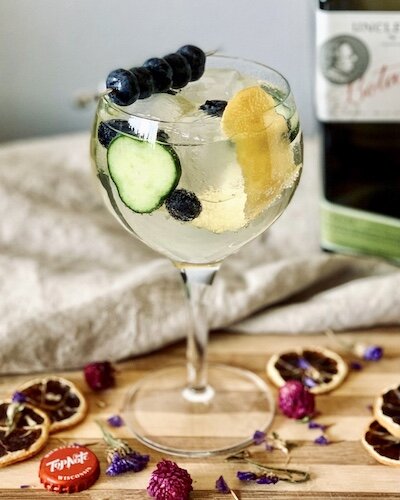How The Spanish Perfected the Gin & Tonic
The Spanish ingeniously elevated the gin and tonic from a simple highball into a drink that stimulates the senses. If you love a good gin and tonic, then you’ll absolutely adore a Spanish G & T. “They’re an occasion,” says Mary Pellettierri, founder of Top Note tonics and mixers. “I was lucky enough to get to Spain before the pandemic and got to experience it for myself. They make it a whole cocktail experience.”
Daniel de Oliveira, corporate mixologist for Southern Glazer’s Wine and Spirits of Illinois would agree. He is getting more and more frequent requests to help set up entire Spanish gin and tonic menus at bars and restaurants and shares, “Three times, I’ve been talking about Spanish gin and tonics just today.”
What’s a Spanish Gin & Tonic?
Spanish G&T with Bitters photo credit Steph Achter for Top Note Tonics
Essentially, a Spanish gin and tonic is the next step up from combining an upscale gin with an upscale tonic. It starts with a big goblet or balloon wine glass, which is filled with ice. Then, a gin and a tonic are selected to pair well together, and then, instead of just a wedge of lime, all sorts of wonderful, aromatic garnishes are added. “Usually, there are three, maybe four, components,” Pellettieri says. “There’s some herbaceous notes, some spice in there and some citrus. And sometimes bitters. Angostura bitters can turn the drink pink, and it’s another component to add just an extra bit of flare. There are just so many cool things you can do.”
“The coolest thing about this is that it is a fancy, simple drink,” de Oliveira says. “A lot of times we kind of forget that the simple drinks, when done really well, are really delicious.” Even the fanciest Spanish gin and tonic is easy to make. “It’s a simple build drink,” he says. “It doesn’t require any shaking or stirring or any cocktail technique.”
History of the Spanish Gin & Tonic
There’s a legend about how Spain turned gin and tonics into an artform, de Oliveira says. “I heard this story from a Fever-Tree rep,” he says. “Chefs in Spain would take their gin and tonic back into the kitchen, and as they would cook and chop up ingredients, they would toss them into their drink. I can (envision) a chef chopping up cucumber and herbs for a salad and tossing them into a drink. I don’t know that it is true, but it’s a fun story.”
Tips for Making Spanish Gin & Tonic
The first rule, de Oliveira says, is to not take tonic off of a soda gun in a bar or from a cheap can at home. “If you’re not using a quality tonic, the drink is going to be trash,” de Oliveira says, no matter what fancy garnishes you add.
For a great Spanish G and T, Pellettieri says to first take note of the botanicals in both the gin and the tonic that you’re planning to use. “You want to riff on the notes of both and put elements of them into the glass,” she says. “It requires a little bit of research to understand what’s going on. Or you can just go by your own palate and what you like.”
Pellettieri says one night she was at her friend’s house, and to make a Spanish gin and tonic that night, she took her Top Note Indian Tonic, paired it with Uncle Val’s gin, and then rummaged through her friend’s refrigerator for garnishes. “I took some basil and lemon, and then I added some pink peppercorns,” she says, adding that the resulting cocktail was absolutely delicious.
“If you’re using a Roku gin from Japan, and since yuzu is one of the botanicals, I like to pair it with the Fever Tree elderflower tonic, and then it’s got a really beautiful, rich peach flavor and almost a lychee flavor so you” could go with those garnishes, de Oliveira says.
Adding It to the Menu
For bars and restaurants that are looking to add a gin and tonic menu, they can go with a menu of gins paired with tonics and garnishes, but it’s also a really fun cocktail to pair with club service. “It’s very classy, and it gives the guest the chance to personalize their own drink,” de Oliveira says. “Carefully curate your own menu of what gins go with what tonics, and make sure you have gins from around the world, and then have some garnishes that are similar to that place or region of the world to represent the spirit and to elevate it as well.”
For home bartenders and even restaurants, Pellettieri recommends using their gardens. “It’s a discovery process,” she says. “And it’s a drink that changes as the garnishes sit in the drink and it warms up and dilutes.” Adds de Oliveira, “It’s just an all-around nice experience, especially sitting on the patio in summertime. There’s nothing better than that.”
Ways to Dress Up Spanish Gin & Tonic
Botanical Spanish G&T photo credit Steph Achter for Top Note Tonics
· Fruit: Citrus peels, wedges and wheels (lime, lemon, kumquats, Meyer lemon, grapefruit, tangerine); berries of all kinds (strawberries, blueberries, gooseberries, blackberries, raspberries, etc.); cherries and currants; peaches, nectarines and pears; tropical fruits (kiwi, pineapple, lychee, etc.).
· Herbs and Vegetables: Cucumbers, celery, peppers, edible flowers, basil, mints, rosemary, sage, tarragon, lemon verbena, winter savory, borage, etc.
· Spice: cinnamon sticks, cloves, juniper berries, lemongrass, star anise, cardamon pods, cumin seeds, peppercorns, etc.
· Bitters: angostura, orange, and citrus.



